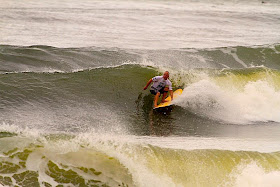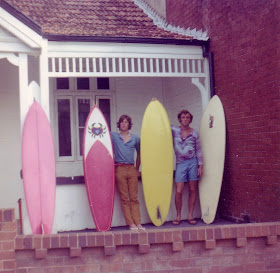A look back at Tigger's formative years surfing and shaping, by Alex Williams
Q: a list of who you learnt from, who worked with you or you collaborated with and anybody that went on to do there own thing? or work with others?
Top Kiwi board makers Terry Lysaght and Roger Land taught me the craft of board making when I first set up Tig surfboards in 1967.
In Australia for the World Titles in 1970, I was impressed by the designs of Wayne Lynch, and Terry Fitzgerald. My Aussie influenced shapes were produced under the Tigger Newling Surfboards logo and included the board I rode to victory in the British Titles in 1973.
In Hawaii, Gerry Lopez, Tom Parrish and Dick Brewer influenced my shaping once I returned to Cornwall and started making Jolly Good Surfboards in 1975. These boards featured artwork from Hawaiian Nancy Dinmore, and were shaped on St Merryn Airfield by me and finished at Porthtowan in collaboration with Tris Cokes and John Manetta at Tris Surfboards.
Tigger at Porthleven ,1975. Photo Dave Weight
Q: On the interview side, I wanted to sort of find out how it was in those early years, of seeing shapes when you traveled and putting them into practice back at home Trials & Tribulations?
Phase 1 Tig Surfboards
Proud to be a backyarder
I started making boards under the label TIG Surfboards, in 1968. It was a real 'backyard' operation.
The short board revolution had just hit, and I was itching to try the new shapes I had seen in Australian surf magazines and films like Paul Witzig's 'Evolution'. Because established local board builders were slow to produce short boards - 'its just a fad that won't last'… and I couldn't afford to buy a new board every other week anyway, I decided to do it myself in my back yard at Treyarnon Bay. My father let me use the greenhouse. So I pulled out his prized tomatoes, and started shaping.
On my own track
The first boards I shaped were 8 foot long, then as the short board revolution gathered momentum, every board I shaped got shorter than the previous one eventually they ended up around six foot long. At first I copied Bob McTavish's Australian designs: tear drop shaped 'trackers', with deep vee bottoms and big Greenough fins. The boards that Wayne Lynch and Nat Young were then riding. But as soon as I surfed these crude copies I had shaped, I needed to get back in the shaping room and make modifications and refinements to improve them. Soon I was embarked on my own unique design track that was driven by how my designs performed in the water. Surfboard building was turning out to be my dream job - combining rocket scientist and test pilot!

Charles Williams and Tigger with contest spoils, late 60s
Recycled prototypes
At first, Tig Surfboards was not a proper job - just a creative hobby. I was just happy to be making new boards for myself and my family. However, thanks to all the keen young local surfers, I kept selling my discarded prototypes at prices that easily covered my costs. Pretty soon I seemed to be surfing with a flotilla of not just family but also a crew of local grommets all happily ripping on my cast-off shapes. Next I was being asked to make boards for older locals and holiday makers, so Tig Surfboards started showing a profit. I bought myself a VW Kombi and headed to Morocco on the proceeds.
The next summer I was busy enough to employ staff: Shaper Roger Land and Laminator Terry Lysaght were both very experienced kiwi board builders who somehow put up with a very green 18 year old boss. One afternoon we posed for our first publicity shot. It was inspired by Pink Floyd's Ummagumma album cover (designed by Hypgnosis). The one where all the band's gear is laid out on a runway. We emptied the greenhouse and laid all the tools and templates out on the lawn along with some boards and a pair of trousers which were so encrusted with resin that they stood up by themselves . The three of us standing there covered in dust - a true start-up cottage industry.

Tig publicity shot 1970
The Warp Factor
There were trials and tribulations though: board surfblanks in the rough shape of surfboards were not available at the beginning, so I had to use blocks of industrial insulation foam. Getting the right bottom curve to stay in the board was a nightmare. One disastrous board slowly warped until it had a pronounced "negative rocker" where the nose curved down into the water instead of up. To his credit, my mate Jo Partridge somehow mastered this seriously flawed design. Stringers solved the warp factor, and soon my dad decided to clear out the potting shed and start his own business 'blowing' surf blanks. It was so much better shaping proper blanks with a nice curve maintained by a wooden stringer, even if my power plane struck voids like swiss cheese.
The Newling clan, 1969, from Observer magazine
Phase 2 - Tigger Newling Surfboards
After a period 'in exile' from Cornwall working in a recording studio in London, then studying Building at Bristol Polytechnic, I gave up all pretence at getting trained for a 'proper' job and returned to the bohemian life of surfboard building and competitive surfing. This time I hit the jackpot, winning the 1973 British Championships convincingly on one of my own shapes. I was riding a 6'6" x19" rounded pintail I had shaped, and it performed perfectly in the big, hollow waves at Freshwater West in Pembroke. The board sported a new logo I designed: 'Tigger Newling Surfboards' surrounding an impossible triangle graphic, signalling a new phase in my surfboard building. Leaving my dad's greenhouse behind I set up a new factory on St Merryn Airfield - a disused World War II airbase owned by Bob Partridge, a local farmer. St Merryn Airfield was a ghost town which other local board makers like Space Gypsy and Fluid Juice would discover too in later years. Bob was an easy going landlord, but his hobby was flying and after surviving several terrifying landings on the broken tarmac runway I quickly learnt to politely turn down his invitations to join him for a few 'circuits and bumps' in his light plane. My 'Tigger Newling Surfboards' phase ended when I left Cornwall in January 1975 to take up an invitation to compete in the Hang Ten American Pro at Sunset Beach in Hawaii. I nearly missed my flight after spending 20 minutes trying to fit my 8 foot big wave board inside a London Cab on my way to Heathrow.

Phase 3 Jolly Good Surfboards
My third phase of surfboard building was a co-operative effort with Tris Surfboards and was influenced by my trip to Hawaii in 1975. My experience in Hawaii included working for Gerry Lopez at Lightning Bolt on Maui where they had successfully decentralised the process of making boards. It was common for shapers to work in their own workshops often in a shed in their own back yard, then take the shaped foam blanks to another factory where they were finished. I tried this idea, shaping in the old chapel building on St Merryn Airfield, and then transporting the blanks down to be laminated by John Manetta and finished by the crew at Tris Surfboards in Porthtowan. Another Island-Style look to many these boards was provided by Nancy Dinmore, a visiting Hawaiian artist who created unique airbrush designs on many of these boards. The logo changed again, my school friend Nick Kavanagh who had accompanied me to Ireland on my first overseas surf safari in 1966, created a great logo featuring two hands clasping that looked like it came out of the Beano. Tris and my favourite comic. With a gently satirical salute to British culture, we called them Jolly Good Surfboards.
Tigger shaping Jolly Goods at the St Merryn factory
Surfing in The Sixties
Surfing in those early years in Cornwall was an amazing adventure which built a real camaraderie amongst us all. Instead of trying to avoid other surfers, you were looking for someone to go surfing with. The locals were a tribe who shared something unique and when travelling surfers visited Cornwall, they got the royal treatment from local surfers. It was an inspiration to share local Cornish waves with visiting overseas surf stars like Bob Cooper, Keith Paull, Twizzle, Goody, and Corky Carroll.
During The Sixties everything changed - even surfboards. Heavy, long malibus morphed into Plastic Fantastic Vee Bottoms. Every surf magazine you opened in the 60s brought a radical new design. Even today, surviving examples of those revolutionary 60s surfboards are treasured by collectors and retro enthusiasts.
At the English nationals, 1969
Surf Spots I pioneered
I had some epic uncrowded sessions at Mundaca after discovering the river mouth left near Guernica in The Basque Country with Roger Mansfield and Bobby Male in the 60s. In Cornwall, I first surfed Porthleven on a longboard in about 1966 when it was still a secret spot, and loved that reef so much I surfed it every opportunity. Around 1973, under the urging of film-maker Rod Sumpter, I paddled out alone in winter and dropped into several 20 foot plus Cribbar waves off Fistral - a near death experience. I was always on the lookout for new spots. The stretch of Cornish coast from The Padstow Estuary to Bude being a rich hunting ground starting with Daymer Bay and progressing North through Spot X and other breaks still too secret to reveal!
At Manly, en route to World championships at Bells, 1970 , with Graham Nile
Q: the group you surfed with, your piers and friend that may have influenced you direction?
I belonged to two groups. Living at Treyarnon Bay, I belonged first to The Trevose Head Crew, then after a stint studying at Camborne Tech in 1968, I was adopted by the Porthtowan Crew as a visiting member. Both groups were packed with colourful characters. I surfed Treyarnon, Constantine and Boobys with my extended family, Petroc, Slim, Sprout, Mike Dodd, Jo Partridge, the surfing grandmother - Nan Shliffke and South Coasters Graham and John Nile, Steve Daniel and Surf Photographer Alex Williams. Porthtowan and St Agnes surfers included Tris Cokes, John Manetta, Neil Wernham, T-Paul Thomas, Derek, Gareth Kent, Chris Clay, Steve Bunt, and his mate Steven Jones (I am sorry to say Steven inherited my clapped out Citroen 2cv and all its mechanical problems!). I would also like to remember Mike Dodd, from Trevone and Paul 'Ju' Jury from Widemouth - two late great surfing mates of mine.

Tigger has lived in Australia for many years, and still competes succesfully and with style. This is him at a comp earlier this year, photo Alex Williams.









All very different from skateboards on the hill in Bryanston Village.
ReplyDelete